SUMMARY
This is AI generated summarization, which may have errors. For context, always refer to the full article.
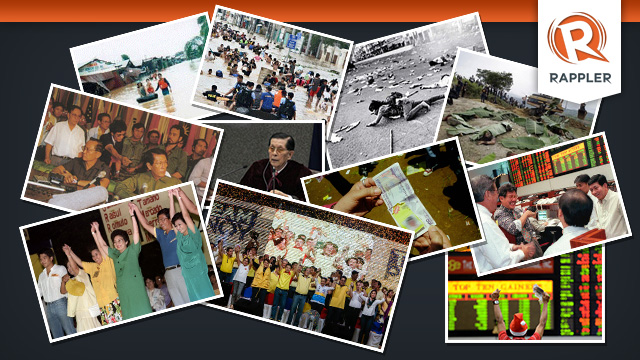
(UPDATED) MANILA, Philippines – It’s been 27 years since the first Edsa uprising. Rappler looks back at the cultural and technological touchstones that separate one generation from the next—from communications to lifestyle to language. The paradox of the Philippines is that, despite the inevitable change at the surface, at the core, everything remains the same.
Everything changes
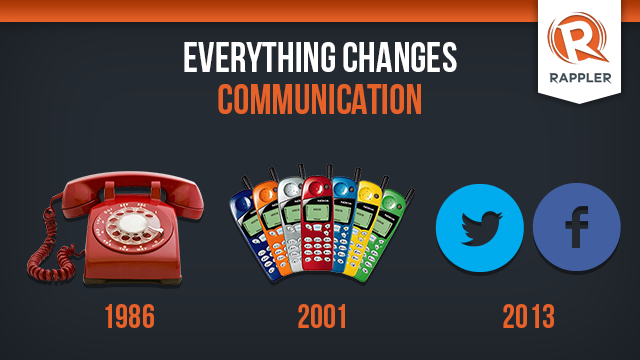
1986: The People Power revolt was powered by good old phone brigades, door-to-door campaigns and word of mouth.
2001: Text messages sent thousands to Edsa to support the call for the ouster of former President Joseph Estrada.
2013: Text, e-mail, Twitter, Facebook, and blogging changed the face of movements and upheavals – think Arab Spring, the London Riots, and Occupy Wall Street. Not surprisingly, the Philippines is now Facebook’s top market in the world – evolving from the text messaging capital to social media capital of the world.
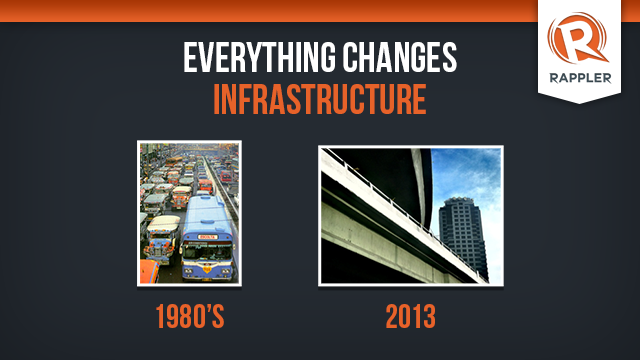
1980s: Aside from the Light Railway Transit that became operational in 1984, underpasses are the rule-of-thumb in metro infrastructure, leaving the blue skies of Manila largely unobstructed.
2013: Now it’s a crazy network of flyovers, railways and pedestrian walks everywhere, with less skyline to admire during bumper-to-bumper traffic.
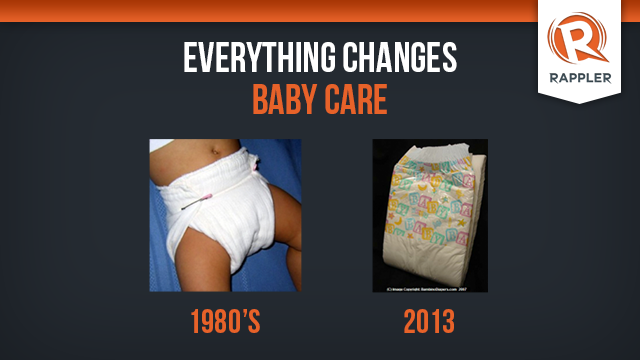
1980s: Bird’s nest cloth diapers and safety pins are still de rigueur. Ouch. How about soiled diapers in the laundry? Eew.
1990 – present: Mommies, don’t you just love modernity? And let’s not even start with the life-changing benefits of adult diapers.
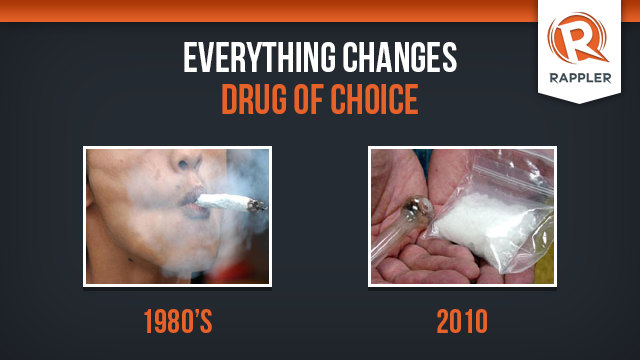
1980s: Cannabis or marijuana is the drug of choice.
2010: Crystalline methamphetamine or shabu is the most commonly used drug.
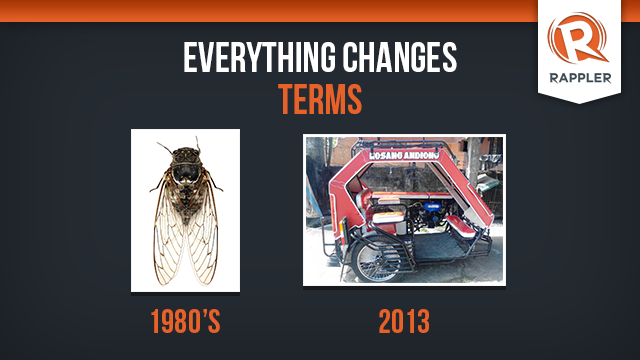
1980s:
Text – written or printed words
Kuliglig – Cicada, a night insect
Call Center – A place for long-distance calls
2013:
Text – Message via Short Messaging System
Kuliglig – Motorized pedicab or tuktuk
Call Center – A company that handles costumer calls
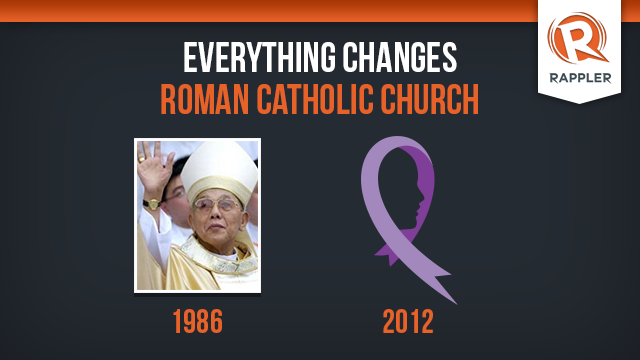
1986: The Catholic Church is a force for change, a vital ally in the anti-dictatorship struggle.
2012: The Catholic Church is a force for conservatism. But even the Church cannot push back change. Despite the pastoral messages on the evils of contraception in Congress, the RH bill passes into law.
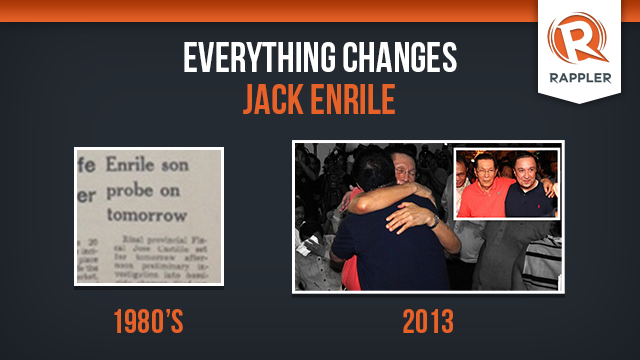
1980s: Manila is abuzz with the exploits of “bad boy” Jackie Enrile, son of Martial Law implementor, Juan Ponce Enrile.
2013: Jack Enrile supports the RH bill, openly talks about his “wild” days and runs for senator.
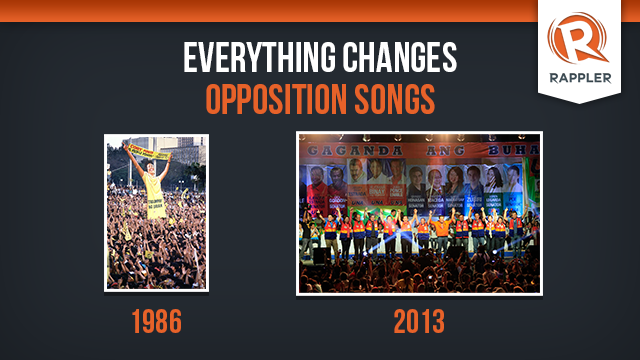
1986: Songs “Tie a Yellow Ribbon” and “Bayan Ko” become the national anthem of the opposition.
2013: Korean pop idol Psy’s “Gangnam Style” becomes a hit at campaign sorties of opposition coalition UNA.
Everything remains the same

1986: The reluctant housewife Cory Aquino runs for president on a platform of change and wins.
2010: The reluctant son Noynoy Aquino runs for president on a platform of change and wins.
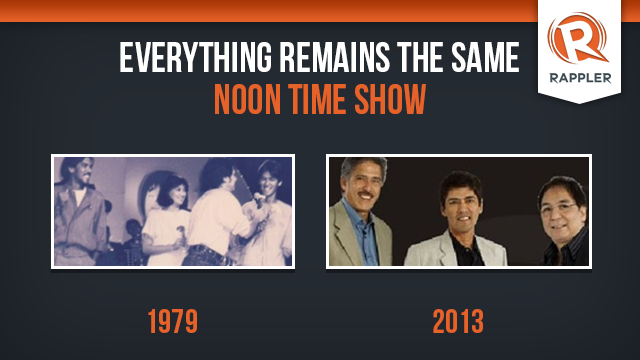
1979: Eat Bulaga goes on air and dominates the noontime slot.
2013: Many co-hosts/girlfriends later, the trio’s raunchy jokes still hit home with the Pinoy masa.

1987: TV Patrol catapults to No. 1 after reformatting as a tabloid newscast with radio talent Noli De Castro as anchor.
2011: One of the funniest tweets to come out after massacre convict Hubert Webb is acquitted: Di ba mabibigla si Hubert na after 15 years, si Kabayan pa rin ang anchor ng TV Patrol? (Wouldn’t Hubert be surprised to see that after 15 years, Kabayan Noli de Castro is still the anchor of TV Patrol?)
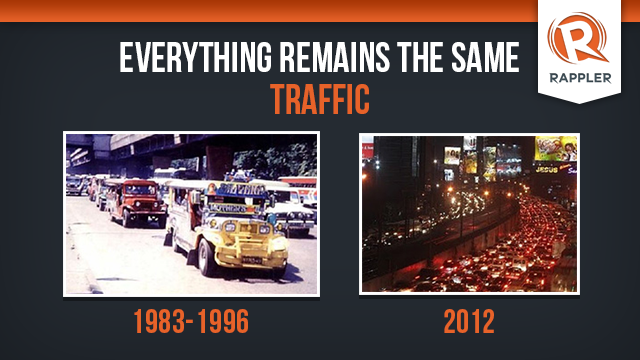
1983-1996: Traffic jams are described as “horrendous” by a UN Habitat report. Average travel time in Metro Manila rises from 42 minutes to 53 minutes, one of the highest figures in the world at the time.
2012: CNNgo.com lists Manila as the world’s third worst city for driving.
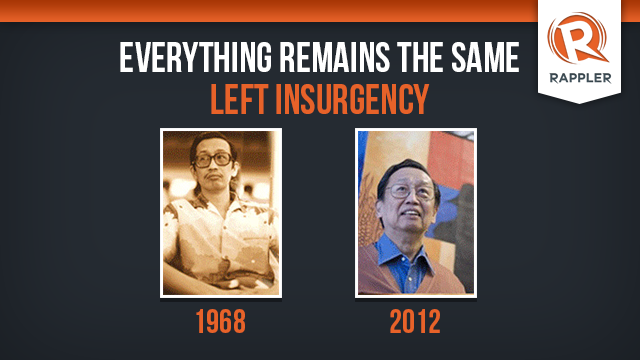
1968: UP professor Jose Maria Sison establishes the Communist Party of the Philippines on December 26, the birthday of communist China’s Chairman Mao Zedong.
2012: The CPP considers its present struggle to be in the “advanced sub-stage of strategic defensive,” a stage it has been in for at least 25 years. It is the longest running communist insurgency in Asia.
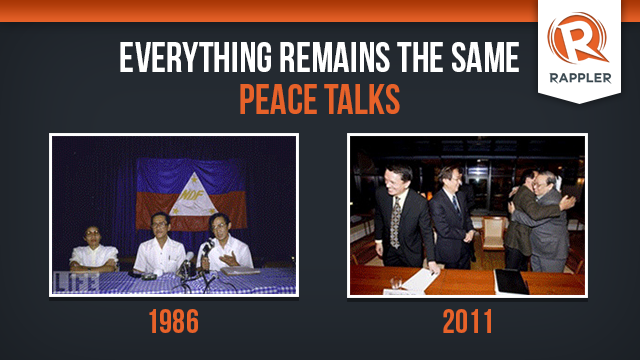
1986: The Left starts talking peace soon after President Corazon Aquino assumes office. For over 2 decades the Philippine government and the NDF conduct 40 rounds of intermittent talks.
2011: 24 years since the first peace talks, the Philippine government and Red leaders resume peace talks, making it the longest-running peace negotiations in the world. But peace talks are never sweeter the nth time around. Talks cool down in 2012, while the combatants gear up.
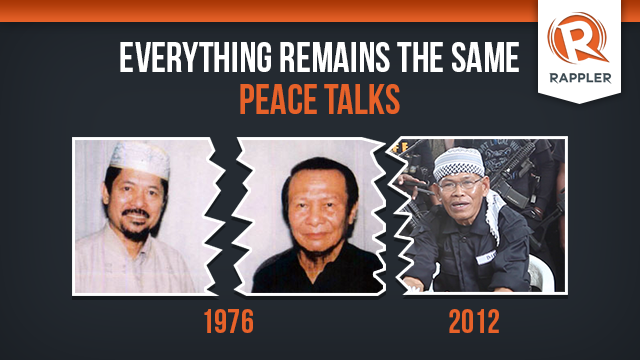
1976: Negotiations for a peace agreement with the Moro National Liberation Front (MNLF) triggers the breakaway of what will later come to be known as the Moro Islamic Liberation Front led by Salamat Hashim.
2012: MILF negotiations with the government for a peace agreement agreement agitates radicals led by Ameril Umra Kato who forms a breakaway group.
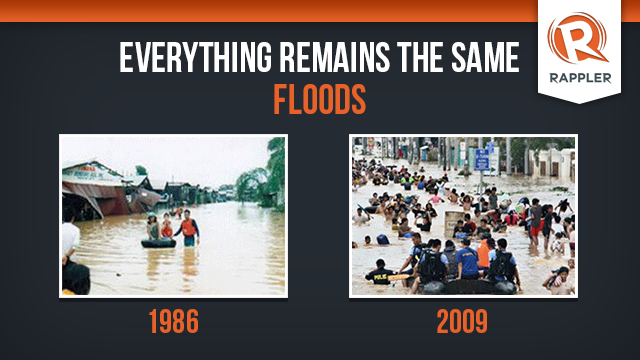
1986: Typhoon Miding (Wayne) inflicts serious damage with floods covering 16% of Metro Manila. Major flooding also occurs in 1988, 1995, 1996 and 1997.
2009: Typhoon Ondoy (Ketsana), dumps the biggest amount of rainfall in recent history, catches government weather agency PAGASA flat-footed with outmoded doppler radars, and the National Disaster Coordinating Committee with just 15 rubber boats for rescue operations.
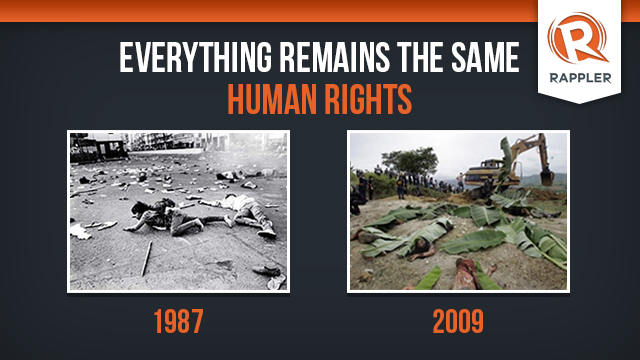
1987: The Mendiola massacre, the 1987 violent dispersal of a farmer’s rally where 13 peasants are killed, and the “unsheathing of the sword of war” against communist rebels, make for a spotty human rights record for Mrs Aquino.
2013: Despite promises, President Aquino has not prosecuted a single case of extrajudicial killing or enforced disappearance in the country. The toughest challenge is prosecuting the powerful Ampatuan family, prime suspects in the massacre of media men and members of the Mangudadatu clan in 2009. The massacre is the single deadliest event for journalists in history.

1983: The book “Luha ng Buwaya” by Amado V Hernandez comes off the press, with the buwaya or crocodile as the central symbol of corruption. Studies in 1998 and 1999 say corruption is pervasive and deep-rooted with very large amounts of public funds lost to both political and bureaucratic corruption.
2011: Tales of large-scale corruption by former AFP Comptroller General Carlos Garcia boggles the imagination of Filipinos and keeps viewers glued to the best reality show in town: Lives of the Rich & Corrupt. The suicide of another implicated general, former AFP chief Angelo Reyes, adds tragedy to the mix.

1960–1980: Ferdinand Marcos, Teofisto Guingona, Lorenzo Tañada and Claro M Recto leave their mark on the Senate – some infamous, some sublime.
2013: The surnames are still there in the august halls of Congress. Alas, the scions aren’t as stellar.
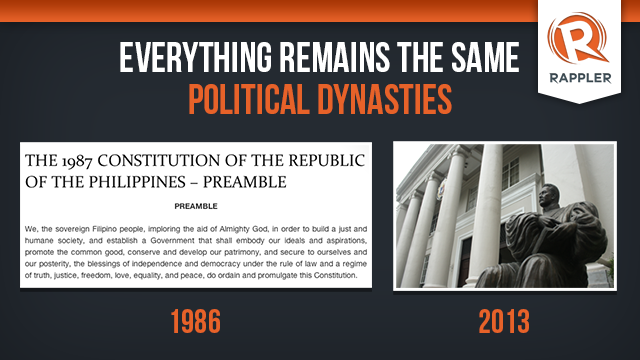
1986: The framers of the new Constitution put in a provision prohibiting political dynasties.
2013: The Supreme Court rules Congress cannot be compelled to enact an enabling law on political dynasties.
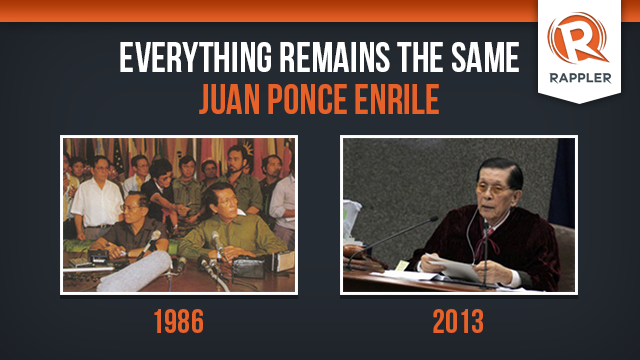
1986: Defense Chief Juan Ponce Enrile takes center stage as the man whose defection brings down a dictator.
2012: Impeachment Presiding Officer Enrile takes center stage as the man whose leadership helps bring down a Chief Justice.

1986: 29 Commission on Elections (Comelec) computer technicians walk-out during the final tally of the snap elections due to massive tampering of election results.
2013: Election watchdog PPCRV says elections have evolved from retail, individual vote-buying, to wholesale vote-buying on the barangay level.
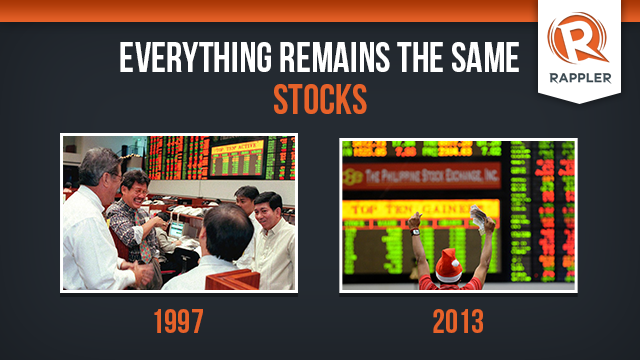
1997: Finance Secretary Roberto De Ocampo uncorks a champagne bottle on the stock-exchange floor toasting the Philippines as “the blooming tiger economy of Asia.”
2013: World Bank Philippines Country Director Motoo Konishi says, “The Philippines is no longer the sick man of Asia, but the rising tiger.”

1987: “Sha sha sha, si Letty Ramos Sha” is an instant hit catapulting EDSA uprising hero General Fidel Ramos’ sister to victory.
2013: 26 years after, Candidate Jamby Madrigal does a Shahani with the campaign jingle “Jajajajamby Palaban.”
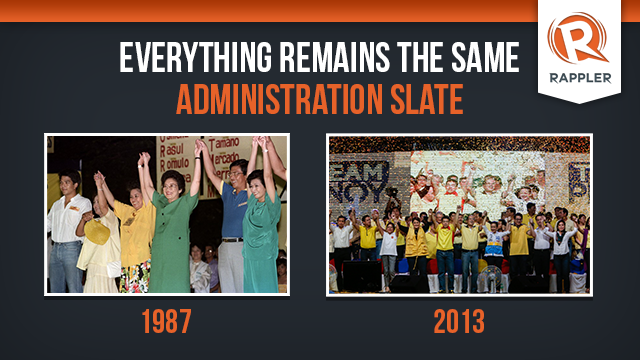
1987: President Cory Aquino asks for a landslide victory for her senatorial slate to banish the ghost of the past, strongman Ferdinand Marcos.
2013: President Benigno Aquino III, asks for a landslide victory for his senatorial slate to banish the ghost of the past, President Gloria Arroyo.
Cicada image from Shutterstock.
-Rappler.com
Add a comment
How does this make you feel?
There are no comments yet. Add your comment to start the conversation.